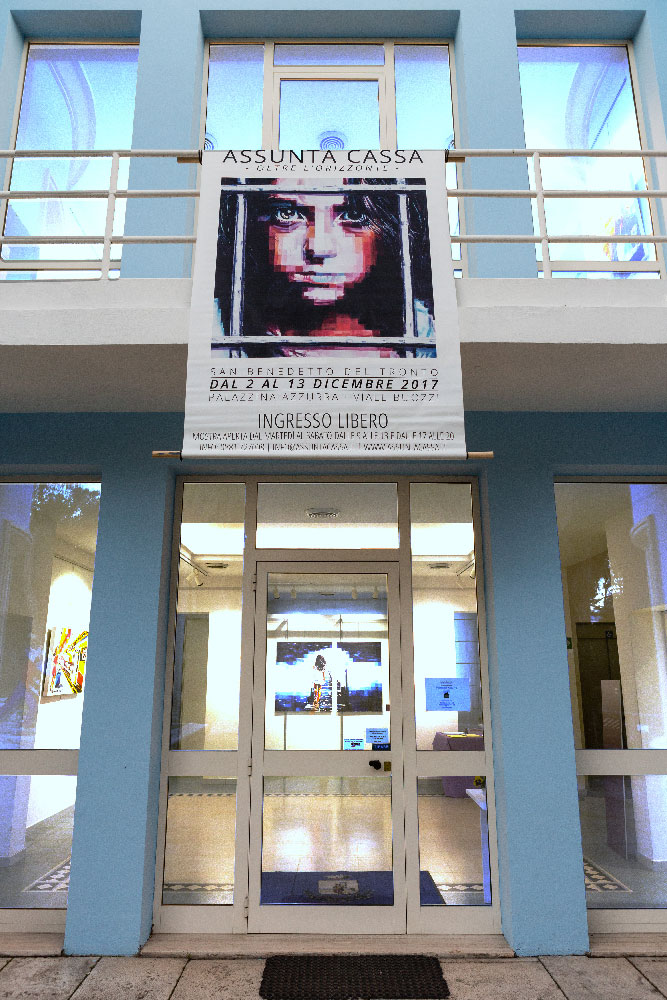
Assunta Cassa places her figures in urban landscapes, dancing, in everyday poses of kissing couples, or women with defiant eyes.
Giuseppe Bacci

Assunta Cassa places her figures in urban landscapes, dancing, in everyday poses of kissing couples, or women with defiant eyes.
Giuseppe Bacci

Assunta Cassa places her figures in urban landscapes, dancing, in everyday poses of kissing couples, or women with defiant eyes.
Giuseppe Bacci

Assunta Cassa places her figures in urban landscapes, dancing, in everyday poses of kissing couples, or women with defiant eyes.
Giuseppe Bacci

Giuseppe Bacci
For the sake of dreams: The Pixel Paradigm in the Art of Assunta Cassa
The artistic research Assunta Cassa has pursued thus far constitutes a carousel of works and ideas so rich in colour and nuance as to suggest she wants to deplete her entire cosmos of imagination and intellect. Slowly, meticulously, faces and ideas slide forth from chiaroscuros, emerging to assert themselves in the strong strokes and expression. The pixelated faces reflect ideas personified and oozing passion through the intensity with which they experience their inner story. Cassa’s pixels are a requisite reference in her pictorial research: to contemplate them we must keep a certain physical distance, otherwise the images they compose are out of our reach, dissolving into a mess of colour before vanishing completely.
The pixels indicate the countless points that make up the display of a digitalized image on a computer screen, so even for the artist, following the path in reverse, the union of all these miniscule dots generates the frame, then the merging of all the frames reconstitutes the moving image.
The subjects shown in motion and the static quality of the pixels are the paradoxes in the examples used in interpreting Assunta Cassa’s signature style, representing a real oxymoron with regard to the events of her artistic research.
Assunta Cassa devoted her time to studying pixels in order to tease out a dogmatic and creative side, and in this key she subsequently broadened her studies, painting characters more familiar to her. Overall, her portraits ring with an undefined, remotely Renaissance echo.
From this point, her artistic production gradually expanded into the exploration of new territory, further buttressed by adverse events, which Cassa handles with stubbornness and determination, but which encourage her to give free rein to all her energies.
The corpus making up the Libertà section, entirely in indigo, requires a contextual reading of the pictorial texts, which speak of the encumbrance of our limits, errors, rejections, illnesses, unforeseen events of any kind that are a symptom of regression and decadence. These works allow us to grasp the theme of Assunta Cassa’s art, which moulds figures of contemporary life to people an assorted and organic collection that reveal rhyme and reason of art in a “supernatural” perspective. Freedom is symbolized by the colour indigo, which the artist singled out, perhaps inspired by The Color Purple, Steven Spielberg’s 1985 film loosely based on Alice Walker’s 1982 novel. Why did Alice Walker, a renowned novelist, call her novel The Color Purple? Purple is the colour of the flowers in the field where the story starts and ends, defined by the words: “I think is pissed God off if you walk by the colour purple in a field somewhere and don’t notice it.” It is also the colour that alludes to the freedom dreamed of by the women in the film.
If each of us were asked to choose the colour freedom has for us, the answers would be as different as each one of us is different, and every shade that exists would be suggested …
In the works of Assunta Cassa the mannered space of dark colours and rigorous compositions of iron bars expands into glowing faces dominated by the light of the eyes, the part of the body that reflects the soul; eyes that reject loss of freedom with a surplus of light.
The opus Why (2016) leads to the perception of distance, solitude, fragility, because the scenario where daily life plays out is full of suffering and frailty.
Methafors (2017) is a portrait dedicated to Alphonso Johnson, acknowledged as the best jazz-fusion bassist of the 1970s. The work was for the cover of the new album by this famous American musician who worked with international artists like Weather Report, Carlos Santana, Billy Cobham, Wayne Shorter, The Crusaders, Stanley Clarke, Quincy Jones, Sarah Vaughan, Phil Collins, Airto Moreira, and Pino Daniele. In the portrait his face has strong, virile features and gives the impression of remaining aloof while being totally immune to the contamination of the place where he finds himself. A condition that is most often found only in “real people”, whose dignity and pride permeate the air in a positive breath of awareness and responsibility, eager for a different and better future.
Thus we shift from the freedom etched into eyes, with the style of the great and pure, to the freedom of the journey, taking in the freedom of self-determination. The works of the Libertà section reflect in the retreat of the soul as it turns towards that self-determination. In Assunta Cassa’s iconographic evolution, the identification of characters is not yet entirely distinct as the solo individual works their way to their landfall, seeking unconditional freedom and an identity, universal paradigms of human redemption accompanied by intimate suggestions motivating empowerment, manifestations of the weariness of routine, pondering the treadmill of work and days passing. Everything develops in a process ranging from universal to individual, from rationality to sentiment, from fortuitous to intangible, fostering total, unconditional intellectual awareness, kindling desires of the heart, arriving at an act of love with every atom of mind, heart and might: one example is the 2013 I ragazzi che si amano [Kids Who Love Each Other].
There is no doubt that Assunta Cassa has liberated her perspicacious, creative art to be able to speak, declaring love. The woman with the light step (Con passo leggero, 2015) becomes synonymous with mysterious, elusive beauty. The instant that movement and light spring from the train in the 2016 Joie de vivre. Happiness that appears similar to this reaching out to life when the joy and happiness of a girl appear in a pictorial glimpse of light in a foretaste of the bliss of the journey as a synonym of freedom but also of escape, of reconciliation, of peace: nothing is more beautiful than the anticipation of the trip. For the artist, departure is a bold, magical gesture, which will engender joy in the soul of those who know how to afford value to freedom. Her painting is full of whirlwind, thrilling inner reverie, as in the 2014 Fuga [Flight], where the protagonist of the canvas was never assertive and adamant but in the awareness of the act seems to show she will become so.
Unwittingly, in the 2017 work Restare [Stay], the artist wants to engage us in a difficult, thorny decision. Made, perhaps, with pain in her heart and in complete paradox knowing exactly what she flees, but not what she is seeking. And in this case desires are like trains. Traveling is like dreaming …
Valigia [Suitcase, 2014] contributes to strengthening the reflection of how life continues its mysterious, predetermined course. We do not want to imagine the girl worried by the uncertainty of tomorrow, but desires are now her affectionate friends. She sees the future every day as she looks out of the “window” of her soul in an effort to give birth to the “freedom of becoming a woman”. The most beautiful place is one’s own heart.
But the real journey begins in the mind and in having new eyes, explained so well in the orange section Io ti vedo [I See You], where the paintings are emblematic metaphors. The eyes of the mind and heart must harmonize to exclaim at the magnificence of creation with emotion. Nonetheless, sometimes our eyes are blind or what we see often exists in an unapproachable light. So our hurting eyes want to seek the splendour of what surrounds us, since contemporary humanity in its everyday life recognizes before all else the sense of inhuman tragedy and gradually opens the eyes of the mind to discover new aspects of life, in a quagmire of contradictions, happy or adverse circumstances, joys or sorrows.
A world that Assunta Cassa declares loudly with bold colours and vibrant compositions in the fascinating Non Solo Tango [More Than Tango] red pictorial section, which speaks of the urgency of recovering identity, greatness that lies in simple things, sublime nature, aspirational desires. The eager chromatic strokes emphasize passions and impulses perfected in a rarefied atmosphere preannounced from the first pictorial compositions. Assunta Cassa is often inspired by the theme of dance, showing a flurry of mixed feelings, romantic twilight visions, primordial references, the eyes of the subjects full of disturbing doubts, or compassionate gazes, eloquent silences, anguished solitude, universal redemption. The beauty of bodies, shown in the plastic splendour of the gestures and silhouettes of dance, the metaphor rebelling against the grim grey of their lives. These works combine beauty and passion, and classic tango moves expand connaturally, intellectualizing the moving bodies of the dancers, simulating the quivering folds of cloth in traditional tribute. In both cases, there is old and new beauty, quietly suggestive because it can ignite desire for something new by overstating pixels and the indefinite, spurring the imagination to map out magical places. The dances painted by Assunta Cassa capture our attention with situations where her eyes light on the couple and its emotional angst. In the Non Solo Tango section we immediately have the overwhelming impression that these subjects must have stirred her emotionally from the very moment she saw them. This made her style of painting tentative, as if lacking the courage to introduce the concepts she had in mind, put them in place and look into them deeply enough. She did this later, with her innate confidence, in a scenario of quiet, hard and serious work, sketching over and over, always ready to embark on a terse appraisal. And her skilled intuition manifests itself in the perception of the strength of the individuals, treated with the same involvement she reserves for the concepts of life and death, darkness and light, end and beginning, weaving a perfect balance that expresses her love for dance.
The theme of passion, of sensuality, could not escape the artist’s painterly intentions. So over the years, works like Tango metropolitano (2012), Tango on the Street (2013), Travolgente pizzica (2013), Tango del cuore (2014), A tempo di tango (2014), Molo sud (2014), Iloveyou (2015) have taken it in turn to reveal Assunta Cassa’s love of dance, casting the magical spell of form and colour over viewer’s heart. She returns to conjure up that enchantment of line and hue again in the small works found in the blue section, Le cassette. Prêt-à-porter works in which the artist casts onomatopoeic accents on her surname and creates small canvases placed in handcrafted caskets of different colours. Hence the name, which means “small cases”, and the artefact they hold becomes symbolic art: the images are bright, archetypal universal metaphors made into paintings, thus becoming absolute elements that mark the course of her artistic research.
The pages of this catalogue tell the story of Assunta Cassa’s artistic research and how it is enfolded in ordinary virtue, open to setting foot on new shores, in the knowledge that every theory remains an assumption and we must not confuse it with the truth, especially assuming that any theory, even the most elaborate, can be useful at times, but can also shows its limits because human nature has complex origins and is subject to constant change. Mind and body are an inseparable unit: our every gesture or expression, including stillness or silence, take on their own meaning. We can express emotions and feelings through non-verbal language which means it is impossible not to communicate. The inner world of Assunta Cassa is expressed through mediation of the body, externalized in the gesture of painting that becomes the means by which the most complex psychological manifestations are rendered visible, involving cognitive processing and subjective experience, which we call feelings or affections. Emotions lie behind affections and we become aware of them psychologically only through a symbolic and mental process which anticipates what the artist will then produce. Cassa’s commitment has imprinted her artistic research, her efforts succeeding as an analysis of her artistic evolution shows she has achieved her goal. Initially passionate about painting, she became a painter, exhibiting prolifically and also commenting in recent times on art and culture tout court.
Interacting with contemporary times we become experts of extraordinary things in art, pushing the human horizon further – hence the title of the exhibition Oltre l’orizzonte, Beyond the Horizon – in order to plunge deeper into artistic creation.
Assunta Cassa’s research is still in progress, and she cannot fail to open up to more developments in the logic of a “new cultural season” for her artistic growth. It is a case of looking to the future, intuiting the signs of the times to promote new artistic productions.
Anna Soricaro
Symphonies of energy

Assunta Cassa places her figures in urban landscapes, dancing, in everyday poses of kissing couples, or women with defiant eyes. The technique and the tones steal the scene before the figures, rendering unique the finished work of a sensitive, innovative and sparkling artist. Bright colours contrasting with black absorb light and intrigue the observer, fascinated by the dazzling glow. An uncommon figuration and from a distance the stroke appears abstract, while up close it declares its greatness. A self-effacing hand uses intense tones and small, precise strokes to speak of passions, daily life and underlying emotions. The figuration is a challenge to overcome and Cassa succeeds very well, a magnificent way to speak through memories, intimacy and emotions; the shades are an instinct to manage, a feisty explosion that will engage the viewer. A figuration seeking to grasp the meaning of life through unusual works, with a sensual feel alternating moments of a tango with women portrayed from behind: with great skill the spatula dances in the artist’s hand, composing a symphony that will leave the observer speechless from the first movement to the finale.
Giuseppe Marrone
The quest of Assunta Cassa for delight and dynamic beauty
Sensuality, movement, technique whose gesture, form and matter are scented with the carnal thrill of dance it conveys, compelling it on the eye, calling out to it and enticing the viewer, the recipient of the work who is dazed by an emotion stronger than delighted connection, and feels the inner turmoil triggered by the virtuous explosions of colour and matter. The subject, the dance, the movement, the steps that shift continuous existence, igniting a split second and fixing it forever on the canvas. Dynamic eroticism, rising yet immobile, fast, uncontrollable in mind and in passion, able to erupt in a flash and unleash the fiercest emotion, the sheer giddiness of the most intense perception. Observing the work of Assunta Cassa is like a return to original sin, emotionally speaking, a experience of deep sensual immersion in the colour whirlwind and pulsating movements of the figures, but also of a space that participates and fills the no-man’s-land of this probing, gratifying pursuit of beauty.
Beauty is experienced in the purity of its emotions, but also almost impetuously, like the soft and sensual touch of skin, precisely for the ease with which it is sensed. Gentle sentiment and erotic trait together, speaking the same language of expression, chasing each other, fusing together, attacking one another, and managing to talk thanks to the emotional world that rears up when least expected, reaching the apex and tracing out perceptual geometries that perhaps no one thought could be experimented.
The art of Assunta Cassa has something primal in its emotional factor, no one should miss the thrill of experiencing her works in person, absorbing some of that passion, which enters the mind first and then sinks deeper into the spheres of perception. Sensuality and love, tenderness and passion, move with and in the dancing figures, which surprise with their natural seeking of pleasure in the gesture, the beauty of producing a human movement, again with sheer spontaneity, finding the refined aesthetic sense in the eroticism of the dance. The unwritten pleasure is impossible not to express: it is sought, deliberately imprinted with colour so that the recipient of the opus may be drawn into this sense of beauty flowing across the skin of one who has managed to impose the normality of a woman experiencing emotions for the eroticism of the dance, in keeping with a sense that has to do with the impossible taste of being wordless before the beauty of life. The beauty of life, the joy of life, however, do not always win: melancholy is sometimes a tangible note in some works, but again naturally. Every age of life must be experienced, and painter Assunta Cassa shows a depth and awareness that every moment must be faced and lived with a unique emotional perspective, linked to the vital act that is innate to painting. Now it becomes impossible not to appreciate the opus in which the subject is not only dance and joyous vitality, but also the constant quest for meaning that accompanies and must accompany very minute of a truly authentic existence, whether joyful or not.
Cassa is a complete painter and before that she is a woman who has a developed sense of her own life and pictorial quest. Perceiving the nuances that pulsating emotions drive across her work is like feeling a shiver that travels up the spine to the head, from the eyes – the instrument of perception – that feed the entire body with a strong, discreet sensuality. Technically everything addresses this research, the use of matter that appears and then rarefies itself with deliberate or unconscious desire, to the use of the palette, a purposeful chromatic range sought with the gentle energy of conveying something that arrives promptly and brings delight. This is an aesthetic fact of great depth. No research should exclude the artist’s own awareness of being a medium acting through their art. When the subject is broken down into precise points, Cassa does so in her sense of exploration and there is the power to give a meaning to be found in the geometric attempt to rationalize this complete inner flow that arrives at the boundless outcome of departure, where a train is the existentiell image of opportunity. We cannot know with precision what Assunta Cassa feels when she paints a train, but perhaps it invokes and crystallizes a chance, an opportunity, an ongoing investigation, first existentiell – daily – and then existential, the overall meaning of life.
Were she to accelerate the dynamism when she disassembles, when she imposes a perceptual pace, when she arranges a chromatic order, it would not be a rhetorical but a spontaneous and natural process. It may seem obvious, at this point, but talking about emotions, passions and life is not obvious and there is no process for doing so. Assunta Cassa has her own incredibly successful method for making us feel this, regardless of whether we have experienced the emotion or occurrence, but it is a journey that persuades us to cross the no-man’s-land between body and mind, perceptions and emotions, mind and heart, fusion and quest in this perpetual pursuit, like two dancers who look at each other as they dance.
Rossella Frollà
The Mighty Soul of Colours
The most striking aspect of this artist’s work is her use of iridescent pixels filled with faces, movement, landscapes of the soul just explored by Tango. We are ensnared by a closed loop of passion while all around it flows naturally. The boundaries of shadow and the red light that swallows everything else are intensified. The oxymoron becomes a weightless step, the quick resurgence of a memory and infinite momentum over time, in places peopled by contrasts of red, purple and black, the circus and the theatre, and city suburbs.

There is something that leaves the black to give form and life to colours as if they were offspring carried in every womb. The red swirls across lips, beseeching them. The day traces wonder and passion on bodies, a complete place where the identity of the wounded is lost and we open our arms to the frail and human act of an embrace. Everything supports the lightness of the bodies and there it is, the soul, under the colours, its being showing us our own. Standing there, in an emotion of mine ready to be born. Everything was there: swift, moving sight, the soft touch of light in the intense, free exploration of things. Everything is received like a fresh mounting of overwhelming energy, an inexplicable force that goes beyond the painting and the eye, and already becomes a threshold on this side of a dilated horizon. The figures dance amid the movements of the world and the tango sends a shiver up the spine, another aspect of the source, life that gathers us until the very end where the red rose is held by fingers that skim over lips. Exploding passions plunder hearts, one facing the other, and the artist’s rich emotions follow the moving bodies and tenacious light, overseen by solemn stillness. This strong, pleasing trait erupts from the core and collects every act of the performance. The choir turns and looks to us, meets our eyes, our something else, which in formless black acquires deep essence, rising from the bottom to the top, and a firm, light hand wields the spatula in lively palette choices.